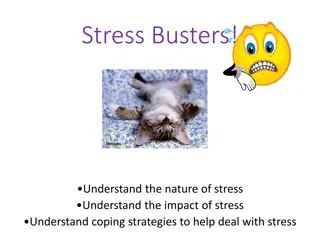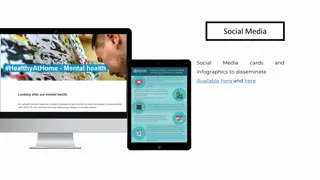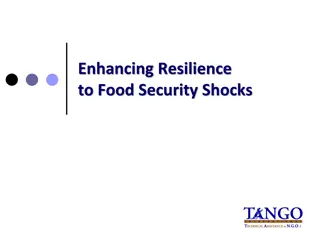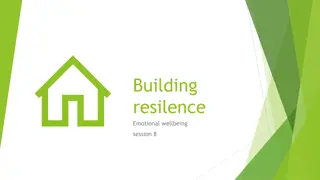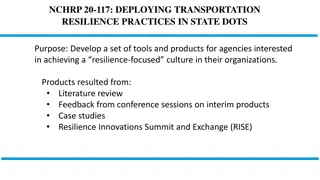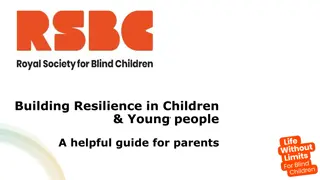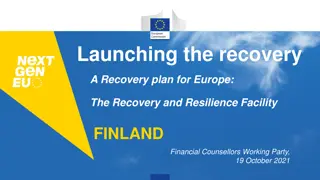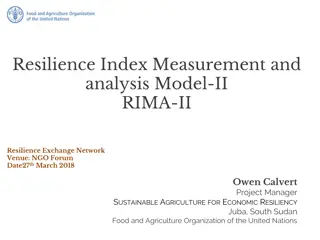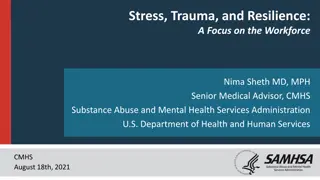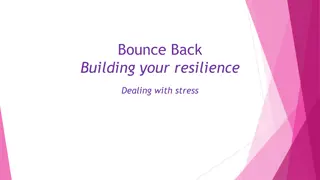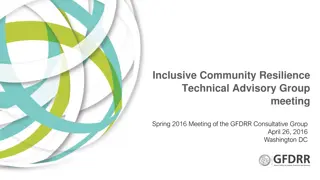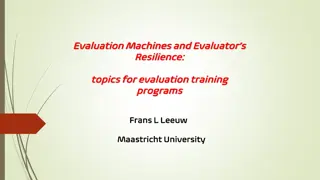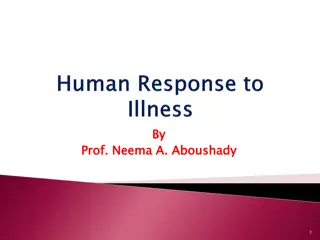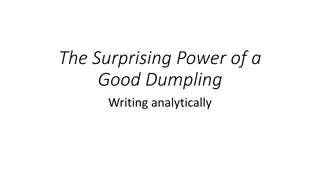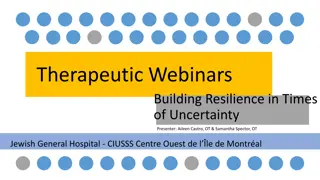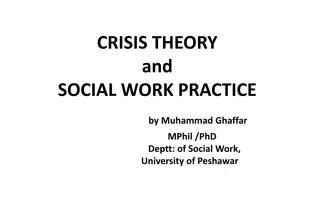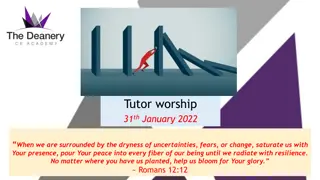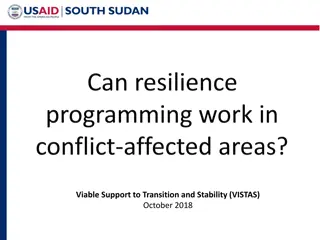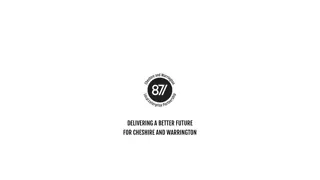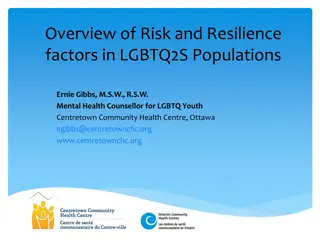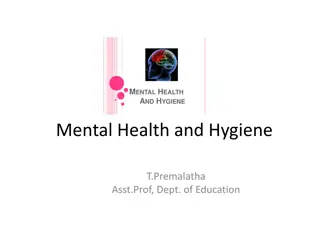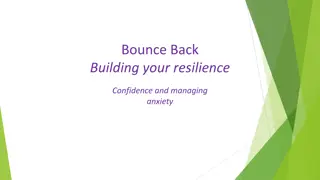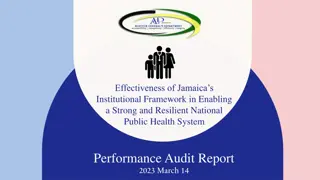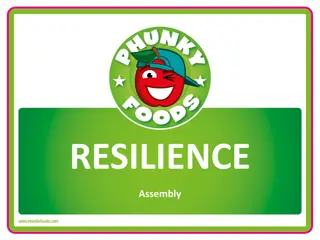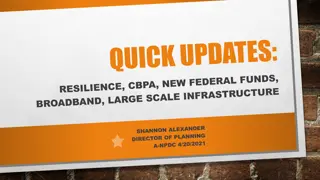Understanding Resilience: Coping and Thriving in Challenging Times
Resilience is the key to maintaining well-being in difficult situations, helping us cope with life's challenges and adapt to adversity. It plays a crucial role in protecting mental health and can be developed by anyone regardless of personal history. Learn about risk and protective factors, reflect on personal resilience experiences, and explore the sources of resilience in our behaviors and circumstances.
Download Presentation

Please find below an Image/Link to download the presentation.
The content on the website is provided AS IS for your information and personal use only. It may not be sold, licensed, or shared on other websites without obtaining consent from the author. Download presentation by click this link. If you encounter any issues during the download, it is possible that the publisher has removed the file from their server.
E N D
Presentation Transcript
Resilience in a recovery context Resilience helps us to maintain our wellbeing in difficult circumstances. Resilience is the ability to cope with life s challenges and to adapt to adversity. Resilience is important because it can help to protect against the development of some mental health problems. We can all develop resilience despite our personal histories. Remember: Being resilient is not about being self-sufficient. Resilience is about thriving under pressure. Sourcing help when you need it is very resilient behaviour.
Risk/Protective factors Protective factors Risk factors Things that push us down the scale are called risk factors and things that help us resist downward pressure or move us back up the scale are called protective factors.
Risk/Protective factors Risk Protective Poor social coping skills Insecure attachments Poor nutrition Poverty Chronic illness Violence in the community Strong bonds within the family Involvement with extended family At least one close relationship Sense of humour Faith A positive attitude to life Good social skills A range of sport/leisure interests Personal goals Good housing Good problem-solving skills Garmezy (1991) found three major categories of protective factors: individual, family & friends, community.
Resilience Think about a time you had to be resilient. This experience could be anything large or small. Consider the following questions: Describe a time when you were able to overcome or handle a major challenge in life. What did you learn about yourself? What personal strengths did you draw upon? Draw upon an image of when you were the most resilient. How might you apply this strength now?
Where does resilience come from? The way we behave is shaped by a range of factors including personality and past experiences, as well as current circumstances and the people around us. All these things therefore influence a person s resilience.
What makes a person resilient? Personal resilience is about self-awareness, coping strategies, getting the right support and being positive. Self-awareness, strategies, and support help you to cope. Feeling able to cope builds confidence and helps you to develop a positive outlook. Confidence and a positive outlook enable you to grow and develop. You then become a source of strength and support for others.
Supporting self-awareness Self-awareness i.e., the ability to observe your own thoughts and feelings. Notice what you are feeling. Ask yourself, What am I actually feeling? Identify the feeling (or feelings). Taking that step back, becoming aware of your feelings and accepting them puts you back in charge and lets you move on. Break the cycle. When you find yourself ruminating, caught up in a cycle of negative thoughts, deliberately turn your attention to something positive (e.g., a good memory). Problem solve. Mentally rehearse how you will deal with the situation. Think it through logically. If you need help, think who you will ask. When worrying is the problem. If you find yourself worrying about a problem that really is outside your control, make a conscious decision to stop ruminating on the problem itself and focus instead on your feelings instead.
Personal Resilience Consider the following questions: What practical resources do you have? What physical resources do you have? What psychological resources do you have? What interpersonal resources do you have? What spiritual resources do you have? We are never, while alive and aware, quite deprived of all choice.
Which of these statements sound likes you There s got to be a way out of this mess and I m going to find it or What s the point? Nothing will ever change People react differently to the same event based upon how they view it, which underscores the point that there is always more than one way of seeing events: in other words, you choose your viewpoint even if, at times, it is difficult to discern any other viewpoint than the current one (Butler and Hope, 2007). So meaning is not static and therefore can change over time.
Our research has demonstrated that the number-one roadblock to resilience is not genetics, not childhood experiences, not a lack of opportunity or wealth. The principal obstacle to tapping into our inner strength lies with our cognitive [thinking] style ways of looking at the world and interpreting events that every one of us develops from childhood. (Reivich and Shatt , 2002: 11)
Blocks to resilience It s not my fault. I am a victim. Helplessness is a hypothesis, not a fact, because it is based on the view that there is nothing you can do to change. Irreparable damage. I ll never get over it. Can a shattered Humpty- Dumpty ever be put together again? Falling apart in the face of significant stress is part of the resilience response because during this period of disruption new ways of responding to life events can be developed so that the pieces of ourselves can be reassembled in a different and sturdier way. I m a failure. There s no point in trying to change. Such self-devaluation keeps the person in a state of demoralised inertia. Experiencing discomfort is intolerable. Also known as low frustration tolerance. The struggle involved is too much to endure; so, the individual looks for the path of least resistance, which in the short term seems the right choice but in the longer-term opportunities for change and growth are missed. Ironically, in avoiding the discomfort of change, discomfort sets in about the stasis in their life ( My life is going nowhere ). In order for their life to go somewhere , it is important to choose productive discomfort or high frustration tolerance (HFT).
Blocks to resilience Why me? Why me? introspection is unlikely to yield any new or helpful information to tackle her distress. A radical change of perspective, however, might provide a different kind of answer. Why not me? states an unpalatable truth: no one is immune from the possibility of experiencing tragedy or misfortune in life. The just world view gets in the way of internalising this perspective. It shouldn t have happened! Denying reality just prolongs and usually exacerbates his current difficulties and frustrations. Pre-determination. You can t escape the past. It is not the past per se that maintains a grip but the person s present beliefs about past events.
Attitude: The heart of resilience I am the type of person who can do difficult things... Our attitude plays a central role in determining how we respond to difficult or dark times in our lives.





